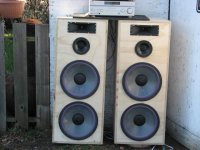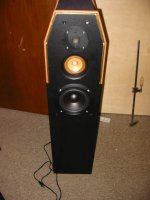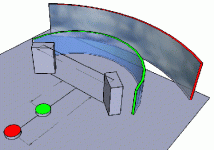I read that some even use clay to dampen the speaker frame of the driver itself. Also Blu-Tack should work.
Maybe I try it out in my speakers.
Maybe I try it out in my speakers.
Last edited:
That is not good of course, but I know you can find clay that wont do that. Blu-Tack I am not sure if it dries out.
http://svenskmodellera.se/proffslera.html
http://svenskmodellera.se/proffslera.html
Last edited:
I read that some even use clay to dampen the speaker frame of the driver itself. Also Blu-Tack should work.
Maybe I try it out in my speakers.
I'm less convinced that this does anything. I have seen woofers with a pretty nasty resonance where the magnet "bounces" on the steel chassis. If they aren't well staked down then they can buzz and manufacturers typically put card gaskets between magnet and chassis for this. I don't think a bit of arm damping would do much for this.
If you are talking about the ringing of the chassis of an unmounted woofer, this largely goes away as soon as the driver is screwed to the baffle (same with a number of horn resonances that people seem to worry so much about).
David S.
Hi Jack, I don't recall mentioning it so here are the systems.Hey Cal, perhaps you've answered this before, but where in the range are you crossing the mids to the bass?
First pic: 100Hz - active - on the Altec 604's
Second: 150Hz - active - on the Sammi Coax's
Third: 600Hz - passive - on the mids
Fourth: 1000Hz - passive - on the Coral holey basket.
Attachments
David I agree, and I think it would take a very large amount of clay for a speaker box to work which is why it is not used (I have never seen this on a speaker). But it is always worth asking the questions and think to learn why something works/do not work.
Modelling clay is oil based and doesn't really dry out.What happens when the clay dries out?
That is one of the locations it is placed.resonance where the magnet "bounces" on the steel chassis.
Modelling clay is oil based and doesn't really dry out.
It will if left on wood and it stains, I have kids!
That is one of the locations it is placed.
Wow, why not just buy a decent driver?!?
It will if left on wood and it stains, I have kids!
Then I suggest you either use it on speakers baskets or sell the kids.
Wow, why not just buy a decent driver?!?
I have a lot of salvaged drivers that could use a helping hand, that's all. It's not going to hurt and if it makes me feel better then it will make the drivers sound better in my mind and perhaps in reality, n'est-ce pas?
I can't actually think of a new driver that it has been done to.
Member
Joined 2009
Paid Member
But it wasn't until I was able to build a special internal structure that really randomized the back-wave, wrapped with absorbent material that I was able to reduce the boxy colorations to inaudible when outdoors.
Jack, can you share with us a description of your 'special internal structure' and why you believe it works so well ?
That's a very interesting thread.. I have been thinking to try absorbing the rear wave of my dipoles for a while now, and even more so after discussing it with Stig Erik. Would large and deep rockwool panels right behing the speakers suffice? Something floor to ceiling, maybe 2m wide, 20 or 30cm deep..on wheels to hide in the visitor's room when not used.
It's not easy to fully treat a living room.. yes, my wife is the boss!😱
It's not easy to fully treat a living room.. yes, my wife is the boss!😱
Member
Joined 2009
Paid Member
I believe it would work quite well, but I believe somebody already noted that any surface - such as the surface of a panel of rock wool, will tend to reflect sound.
I was thinking that a layered approach would work best. The back wave should first encounter some diffuse absorber, some light teased out low density stuff first so that reflections are minimal, and then let the density increase with depth.
p.s. you gotta do something about that boss situation 🙂
I was thinking that a layered approach would work best. The back wave should first encounter some diffuse absorber, some light teased out low density stuff first so that reflections are minimal, and then let the density increase with depth.
p.s. you gotta do something about that boss situation 🙂
I believe you have your dipoles toed in. If your situation is anything like mine, you could probably get away with absorbtion in the red area:.. I have been thinking to try absorbing the rear wave of my dipoles for a while now, and even more so after discussing it with Stig Erik. Would large and deep rockwool panels right behing the speakers suffice?
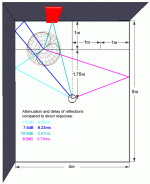
Absorbing the corner reflections seems less necessary, since the delay is greater and the reflection is coming from almost the same direction as the original sound. The corner reflection would widen the stereo panorama, which some people really appriciate while others believe it to be "unnatural". Choose your poison according to your taste. 😎
Rudolf
Thanks Rudolf, that's exactly what I needed! Guess I also have to extend the absorber to the ceiling in that red area.. will try this setup and report. Kudos for the toeing, it works wonders!
Bigun: yes, she is the boss.. she prefers the more spacious sound of no treatment.. audiophile wife, who's lucky hey?? 😉
Bigun: yes, she is the boss.. she prefers the more spacious sound of no treatment.. audiophile wife, who's lucky hey?? 😉
Absorbing the corner reflections seems less necessary, since the delay is greater and the reflection is coming from almost the same direction as the original sound. Rudolf
Unless the delay is very large, >> 10 ms this reflection will be a serious problem that should not be ignored. The fact that it comes from the same direction as the direct sound is a bigger problem, not a lessor one.
Unless the delay is very large, >> 10 ms this reflection will be a serious problem that should not be ignored. The fact that it comes from the same direction as the direct sound is a bigger problem, not a lessor one.
I'd agree. Both the corner reflection and the back wall reflection in that sketch are close enough in angle, compared to the direct sound, to pose difficulty in seperating them out.
Reflections from the same direction as direct sound = response abberation.
David S.
The fact that it comes from the same direction as the direct sound is a bigger problem, not a lessor one.
I'd agree. Both the corner reflection and the back wall reflection in that sketch are close enough in angle, compared to the direct sound, to pose difficulty in seperating them out.
I have read what problems the literature wants me to have. 😉
Some time ago I moved the speakers even further into the room. Now I prefer to listen at the border between direct field and reverberant field in my room:
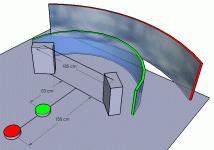
Green is where I listen in the direct field. Less sophisticated recordings tend to be arranged in a half circle - if left/right information is pan-potted solely to its corresponding speaker.
Red is where I listen in the reverberant field. Notice how the acoustic scene walks back towards the front wall. To me this is a strong indication that I recognise the front wall and front corner reflections primarily as a distance indicator and not as part of the first arrival.
Rudolf
Attachments
Very nice graphics.
I'm not sure that your observations indicate anything about the wall reflections. I would hope that a system could portray a range of sound locations from left to right and from the plane of the speakers back toward infinity (at least beyond the wall).
The question with reflections is always whether they seem to be plausible reflections adding to the spaciousness of a recording space or whether they are perceived as response errors. The problem with reflections coming from the direction of speakers (or directly above or below them) is that we can't use binaural hearing to seperate them from the source. In that case they are always perceived as response errors rather than spaciousness.
In the past I have attached simulations of music with reflections added to the direct sound. When done in mono (reflections same direction as the source) you clearly hear the comb filtering. When added to the opposite channel they always sound like an environmental reflection rather than a colored sound.
Dipoles send a lot of energy to the back walls that, if not treated, will reflect forward as your previous diagram shows. Why would you want to treat the back wall bounce and not the back corner bounce?
David S.
David S.
I'm not sure that your observations indicate anything about the wall reflections. I would hope that a system could portray a range of sound locations from left to right and from the plane of the speakers back toward infinity (at least beyond the wall).
The question with reflections is always whether they seem to be plausible reflections adding to the spaciousness of a recording space or whether they are perceived as response errors. The problem with reflections coming from the direction of speakers (or directly above or below them) is that we can't use binaural hearing to seperate them from the source. In that case they are always perceived as response errors rather than spaciousness.
In the past I have attached simulations of music with reflections added to the direct sound. When done in mono (reflections same direction as the source) you clearly hear the comb filtering. When added to the opposite channel they always sound like an environmental reflection rather than a colored sound.
Dipoles send a lot of energy to the back walls that, if not treated, will reflect forward as your previous diagram shows. Why would you want to treat the back wall bounce and not the back corner bounce?
David S.
David S.
The walls in my graph should not be interpreted as a kind of projection screen, where the acoustic scene is fixed too. They just indicate an average curvature of the scene, but don't define the exact distance of the sound locations. If I knew how to paint a curved and transparent cloud, it would have been a better representation.I would hope that a system could portray a range of sound locations from left to right and from the plane of the speakers back toward infinity (at least beyond the wall).
Doesn't it need only a few (horizontal) degrees between the direct sound and its reflection to make them separable for binaural hearing?The question with reflections is always whether they seem to be plausible reflections adding to the spaciousness of a recording space or whether they are perceived as response errors. The problem with reflections coming from the direction of speakers (or directly above or below them) is that we can't use binaural hearing to seperate them from the source. In that case they are always perceived as response errors rather than spaciousness.
Some phantom images, that are projected in a direction near the back wall bounce, tend to be "sucked into" the wall bounce point, when I leave the direct field. It depends on the recording, but is no "rare" occasion. So I would give this priority. Of course you could treat the corner bounce too, but it doesn't do much more than reduce the width of the stereo stage.Why would you want to treat the back wall bounce and not the back corner bounce?
In general: Doing more will help more, but it is not mandatory to go as far as StigErik does.
Rudolf
In general: Doing more will help more, but it is not mandatory to go as far as StigErik does.
Again, this is what I wanted, and was hopping to hear! impossible for me to go that far and as said, some people do prefer some extra spaciousness, I am not sure myself yet..
off topic: tried tonight an el cheapo version of SL's Watson. Boy, that's an interesting one. Some recording go scary precise AND wide, some others, nothing..
Back to our main topic: Kari Bremnes "fyret ved Torneham", that's a song to check OB rattle. My self built Orions are no good, I know that for sure now they rattle like a train track.. Funny how much energy these little 10" can throw on braced wood! And the panel does not vibrate that much on sweeps and such, it's the dynamics that seems to make everything worse..
Again, this is what I wanted, and was hopping to hear! impossible for me to go that far and as said, some people do prefer some extra spaciousness, I am not sure myself yet..
off topic: tried tonight an el cheapo version of SL's Watson. Boy, that's an interesting one. Some recording go scary precise AND wide, some others, nothing..
Back to our main topic: Kari Bremnes "fyret ved Torneham", that's a song to check OB rattle. My self built Orions are no good, I know that for sure now they rattle like a train track.. Funny how much energy these little 10" can throw on braced wood! And the panel does not vibrate that much on sweeps and such, it's the dynamics that seems to make everything worse..

Last edited:
- Home
- Loudspeakers
- Multi-Way
- Box colourations - really ?


